| Pages:
1
2 |
Belowzero
Hazard to Others
  
Posts: 173
Registered: 6-5-2020
Location: Member Is Offline
Member Is Offline
|
|
Nitrate salt sources
Ever since I picked up my chemistry hobby I noticed it has become very hard to find good nitrate sources.
Back in the days I could just pickup 25kg bags of various nitrate salts, to my surprise this has gotten quite a hazzle.
I used to refine ammonium nitrate based fertilizer but since it is now banned for consumer use the closest thing I can find is so called N23 which has
the following composition:
Nitrogen total 23%
NO3 7.5%
Ammonium nitrogen 15.5%
Calciumoxide 11%
Magnesiumoxide 3%
Sulfurtrioxide 25%
I am always confused by the way they write this down.
Since this is an ammoniumnitrate based fertiziler this is obviously present.
How the SO3 is bound is a mystery to me, I looked at some MSDS's but have not found a clear answer.
Could it be ammoniumsulfate?
The goal would be to purify/seperate the ammoniumnitrate if this can be done at a resonable cost.
I am not sure how to go about doing so and if this would be feasable, calciumoxide dissolves well in water, so does ammoniumsulfate.This makes
crystalization an issue.
Any input would be appreciated.
Since I will probably use most of the nitrate salt to produce HNO3 (which became a pain in the ass to obtain too) I can also imagine skipping
purification and try to distill it off from the raw fertilizer with sulfuric acid, perhaps washing out the greasy stuff that is often found in
fertilizers.
Last but not least if we can find a working and economical method to do this it might be interesting for members that face similar problems regarding
these substances.
@mods if you think this is the wrong section , my apologies , please move it 
|
|
|
garphield
Hazard to Self
 
Posts: 58
Registered: 9-12-2019
Member Is Offline
|
|
Looking at that, when you dissolve it in water most of the sulfate will be precipitated out with the calcium. If you filter that off, the stuff
dissolved in solution will be a mixture of ammonium/magnesium sulfate and nitrate, with a significantly higher amount of nitrate relative to sulfate
than before the calcium sulfate was filtered off. I also think that the weight% of NO3 is just the percentage of the fertilizer that is nitrogen in
the form of nitrate, not the total weight of all nitrate including oxygen. It should be about 32% nitrate by weight including the oxygen atoms in the
nitrate ion. I just woke up which is why this isn't worded very well, sorry.
|
|
|
dawt
Hazard to Self
 
Posts: 74
Registered: 9-5-2016
Location: EU
Member Is Offline
Mood: fluorescent
|
|
Those ingredients aren't actually the ingredients, but the elements (Nitrogen, Calcium, Magnesium, Sulfur) written in a way that farmers use to
calculate the amount of fertilizer they need. It's just convention and has been that way since forever. It's most likely a mixture of ammonium
nitrate, ammonium sulfate and some insoluble magnesium and calcium salts you don't have to worry about.
You could remove the magnesium and calcium salts by simply dissolving the rest in water, as ammonium nitrate and sulfate are very soluble. Removing
the sulfate ions might be a little tricky, you could always remove them with a saturated solution of calcium hydroxide, but that's barely soluble by
itself and will require a lot of water. Maybe dump in a bunch of calcium hydroxide, let it stir for a few hours or days and occasionally test for
sulfate by adding saturated calcium hydroxide solution to a sample of your nitrate solution? Then remove excess calcium by adding ammonium carbonate.
You should be left with a solution of ammonium nitrate and a little bit of ammonium carbonate, the latter of which can either be decomposed by heating
or removed by recrystalising.
[Edited on 2020-6-15 by dawt]
|
|
|
B(a)P
International Hazard
    
Posts: 1139
Registered: 29-9-2019
Member Is Offline
Mood: Festive
|
|
Which country are you in? Calcium nitrate is often sold as a fertilizer and that might be a slightly better source of nitrate then what you have
there. Some cold packs contain ammonium nitrate (not in Australia where I live though). What are the legalities with regard to owning nitrate of
purchasing them where you are from? If there is no restriction in that regards there are many reasonably priced online sources (though international
shipping is a bit of a basket case at the moment).
|
|
|
Chemorg42
Hazard to Others
  
Posts: 103
Registered: 12-11-2019
Member Is Offline
Mood: Concentrated
|
|
I buy my nitrate salt as potassium nitrate from stump remover, then synthesize what I need from that. However, if you need a-lot of salt, this method
is not practical, the products can be quite pure though.
In Canada (where I'm from), the best brand I know of is Falling Leaf stump remover (I believe almost pure potassium nitrate.)
Anyone who is not shocked by quantum theory has not understood a single word. (attributed to Niels Bohr)
I think I can safely say that nobody understands quantum mechanics. (Richard Feynman)
|
|
|
Refinery
Hazard to Others
  
Posts: 371
Registered: 17-2-2014
Member Is Offline
Mood: Still
|
|
If you buy calcium nitrate separately and add it to that mess, it would precipitate any sulfates out and leave only soluble nitrates. Excess doesn't
matter since Ca nitrate is a feedstock itself. Where I live, CaN is otc in pure form, but other nitrates tend to be either messed up with inert gunk
or not available at all. Especially ammonium.
Then you would have ammonium, magnesium and calcium nitrate solution, which you could churn into nitric acid with sulfuric acid.
On the other hand, sulfates are inert to sulfuric acid and more is generated upon addition, so it might be an unnecessary step. You just need to
titrate the sulfuric acid to extract all available nitric acid.
[Edited on 16-6-2020 by Refinery]
|
|
|
Belowzero
Hazard to Others
  
Posts: 173
Registered: 6-5-2020
Location: Member Is Offline
Member Is Offline
|
|
Thanks for the replies so far.
| Quote: |
You could remove the magnesium and calcium salts by simply dissolving the rest in water, as ammonium nitrate and sulfate are very soluble. Removing
the sulfate ions might be a little tricky, you could always remove them with a saturated solution of calcium hydroxide, but that's barely soluble by
itself and will require a lot of water. Maybe dump in a bunch of calcium hydroxide, let it stir for a few hours or days and occasionally test for
sulfate by adding saturated calcium hydroxide solution to a sample of your nitrate solution? Then remove excess calcium by adding ammonium carbonate.
You should be left with a solution of ammonium nitrate and a little bit of ammonium carbonate, the latter of which can either be decomposed by heating
or removed by recrystalising.
|
I will try to see if I can get this to work on a small scale, one advantage is that these substances are dirt cheap!
| Quote: |
Which country are you in? Calcium nitrate is often sold as a fertilizer and that might be a slightly better source of nitrate then what you have
there. Some cold packs contain ammonium nitrate (not in Australia where I live though). What are the legalities with regard to owning nitrate of
purchasing them where you are from? If there is no restriction in that regards there are many reasonably priced online sources (though international
shipping is a bit of a basket case at the moment).
|
I agree with you that this might be a cheaper and more direct approach, I'll see if I can find any sources.
Curious how the calcium salt is still OTC and easily converted.
Only downside is that it is always in hydrated form, I don't like buying water 
Quote: Originally posted by Chemorg42  | I buy my nitrate salt as potassium nitrate from stump remover, then synthesize what I need from that. However, if you need a-lot of salt, this method
is not practical, the products can be quite pure though.
In Canada (where I'm from), the best brand I know of is Falling Leaf stump remover (I believe almost pure potassium nitrate.)
|
I've looked around for this and interestingly this seems to be very uncommon on this side of the lake and would probably have to be shipped , making
it a rather expensive solution.
If I can find a cheap source perhaps international shipping is the more viable approach anyway. I guess the potassium or sodium salt are not much of a
problem, AN might be different story.
[Edited on 16-6-2020 by Belowzero]
|
|
|
B(a)P
International Hazard
    
Posts: 1139
Registered: 29-9-2019
Member Is Offline
Mood: Festive
|
|
Other forum members have purchased from these guys https://www.dudadiesel.com/search.php?query=%22potassium+nit...
|
|
|
Belowzero
Hazard to Others
  
Posts: 173
Registered: 6-5-2020
Location: Member Is Offline
Member Is Offline
|
|
I should have mentioned I am on the european continent.
Still appreciated though, I'll check to see if they do shipping and what that would cost.
|
|
|
Eddie Current
Hazard to Self
 
Posts: 78
Registered: 25-7-2018
Member Is Offline
|
|
Quote: Originally posted by Belowzero  |
I should have mentioned I am on the european continent.
Still appreciated though, I'll check to see if they do shipping and what that would cost. |
They sell "Spectracide" in the U.K. 
I'd be surprised if it wasn't sold in the other parts of Europe.
|
|
|
Belowzero
Hazard to Others
  
Posts: 173
Registered: 6-5-2020
Location: Member Is Offline
Member Is Offline
|
|
Quote: Originally posted by Eddie Current  | Quote: Originally posted by Belowzero  |
I should have mentioned I am on the european continent.
Still appreciated though, I'll check to see if they do shipping and what that would cost. |
They sell "Spectracide" in the U.K. 
I'd be surprised if it wasn't sold in the other parts of Europe. |
I'll see if I can order any from the UK, on the mainland this does not seem to be very common or even illegal , weird how these things work.
|
|
|
Mateo_swe
National Hazard
   
Posts: 541
Registered: 24-8-2019
Location: Within EU
Member Is Offline
|
|
Maybe this is what you look for?
Saltpeter on ebay
Sometimes NaNO3 is also called Saltpeter.
The add doesnt seem to tell if its KNO3 or NaNO3 but you can always ask the seller.
|
|
|
Chemorg42
Hazard to Others
  
Posts: 103
Registered: 12-11-2019
Member Is Offline
Mood: Concentrated
|
|
I believe that NaNO3 is usually called Chilean salt peter, but it couldn't hurt to check.
Anyone who is not shocked by quantum theory has not understood a single word. (attributed to Niels Bohr)
I think I can safely say that nobody understands quantum mechanics. (Richard Feynman)
|
|
|
cyanureeves
National Hazard
   
Posts: 744
Registered: 29-8-2010
Location: Mars
Member Is Offline
Mood: No Mood
|
|
Quote: Originally posted by B(a)P  | | Which country are you in? Calcium nitrate is often sold as a fertilizer and that might be a slightly better source of nitrate then what you have
there. Some cold packs contain ammonium nitrate (not in Australia where I live though). What are the legalities with regard to owning nitrate of
purchasing them where you are from? If there is no restriction in that regards there are many reasonably priced online sources (though international
shipping is a bit of a basket case at the moment). |
there is cheap calcium nitrate where i live and was
thinking of making a sodium nitrate salt from this.there is a good youtube video showing how to do that.it involves boiling sodium bicarbonate and
looks very messy.couldnt sodium hydroxide be used and avoid all the boiling?i understand calcium nitrate does not distill very well using sulfuric
acid?why?
|
|
|
B(a)P
International Hazard
    
Posts: 1139
Registered: 29-9-2019
Member Is Offline
Mood: Festive
|
|
You can use either an ammonium or potassium sulfate solution added to a calcium nitrate solution to yield calcium sulfate precipitate and the nitrate
salt in solution.
The reason you don't use calcium nitrate to make nitric acid is because it leaves a solid poorly soluble mess in your glass. If you start with
potassium nitrate the residue is easier to clean up.
|
|
|
Mateo_swe
National Hazard
   
Posts: 541
Registered: 24-8-2019
Location: Within EU
Member Is Offline
|
|
In UK, delivers worldwide i think.
Has a few different Potassium nitrate variants and some other nice chems too.
http://www.chemz4u.co.uk/shop/4593669979/potassium-nitrate-h...
http://www.chemz4u.co.uk/home/4593669975
I have bought some stuff.
A nice guy, seems to be for fireworks hobby.
[Edited on 2020-7-7 by Mateo_swe]
|
|
|
Refinery
Hazard to Others
  
Posts: 371
Registered: 17-2-2014
Member Is Offline
Mood: Still
|
|
Quote: Originally posted by cyanureeves  | | there is cheap calcium nitrate where i live and was thinking of making a sodium nitrate salt from this.there is a good youtube video showing how to do
that.it involves boiling sodium bicarbonate and looks very messy.couldnt sodium hydroxide be used and avoid all the boiling?i understand calcium
nitrate does not distill very well using sulfuric acid?why? |
Calcium sulfate is also known as gypsum. It doesn't want to dissolve into anything, it withstands temps up to +1000C and, well, they chisel statues
out of it, so you don't really want that in your most precious boiling flask.
Calcium nitrate can be converted into sodium nitrate with following equation:
Ca(NO3)2 + Na2CO3 = 2 NaNO3 + CaSO4
In where both are soluble at first, but upon metathesis CaSO4 will crash out of the solution due to insolubility.
Using sodium - BI - carbonate could cause issues, so dehydrate it first by roasting it, or get Sodium carbonate. It is sold as washing soda. Make sure
it's not adulterated with anything.
Molar masses are easy to find. Next thing is just to dissolve both in water and mix'em up, and wait for CaSO4 to settle, then decant, and if
necessary, filter. You can use bentonite clay to increase clarification.
This should be so easy reaction that it is fun to do, but it gets boring quickly.
When you've got clear liquor, just concentrate it and evaporate to dryness, or use as preferred. Mixing it with proper molar ratio of H2SO4 will yield
HNO3 and sodium sulfate, which is highly soluble and hence easy to rinse off.
|
|
|
thors.lab
Hazard to Others
  
Posts: 103
Registered: 19-7-2019
Member Is Offline
|
|
I second KNO3 from stump remover. It worked quite well for making nitric acid.
|
|
|
RogueRose
International Hazard
    
Posts: 1593
Registered: 16-6-2014
Member Is Offline
|
|
Quote: Originally posted by Refinery  | Quote: Originally posted by cyanureeves  | | there is cheap calcium nitrate where i live and was thinking of making a sodium nitrate salt from this.there is a good youtube video showing how to do
that.it involves boiling sodium bicarbonate and looks very messy.couldnt sodium hydroxide be used and avoid all the boiling?i understand calcium
nitrate does not distill very well using sulfuric acid?why? |
Calcium sulfate is also known as gypsum. It doesn't want to dissolve into anything, it withstands temps up to +1000C and, well, they chisel statues
out of it, so you don't really want that in your most precious boiling flask.
Calcium nitrate can be converted into sodium nitrate with following equation:
Ca(NO3)2 + Na2CO3 = 2 NaNO3 + CaSO4
In where both are soluble at first, but upon metathesis CaSO4 will crash out of the solution due to insolubility.
Using sodium - BI - carbonate could cause issues, so dehydrate it first by roasting it, or get Sodium carbonate. It is sold as washing soda. Make sure
it's not adulterated with anything.
Molar masses are easy to find. Next thing is just to dissolve both in water and mix'em up, and wait for CaSO4 to settle, then decant, and if
necessary, filter. You can use bentonite clay to increase clarification.
This should be so easy reaction that it is fun to do, but it gets boring quickly.
When you've got clear liquor, just concentrate it and evaporate to dryness, or use as preferred. Mixing it with proper molar ratio of H2SO4 will yield
HNO3 and sodium sulfate, which is highly soluble and hence easy to rinse off. |
Your equation is messed up. cal Nit + Sodium Carbonate -> CaCO3 + NaNO3
Not CaSO4. You would only get CaSO4 if you add H2SO4 to the Cal nitrate itself.
Also, they make buildings, roads, etc out of the CaCO3, so it's some pretty hard stuff as well.
|
|
|
Belowzero
Hazard to Others
  
Posts: 173
Registered: 6-5-2020
Location: Member Is Offline
Member Is Offline
|
|
So far the route from calciumnitrate seems to be the best approach, the reaction driver makes it straightforward too.
Only real downside would indeed be a rockhard mass with the serious potential to mess up your glassware.
Either the reaction mechanism would have to be modified or a dedicated disposable vessel would have to be used, a plastic container could suffice.
The idea to go to HNO3 directly is attractive too, when distilled into a ammonia solution one could go directly to AN and leaving glaubers salt on the
other end, both useful products.
One downside is the high water content of CaNO3, perhaps I should fuse this before use, might try a microwave to see if that can speed up the process.
I'll order some CaNO3 and try the different approaches to see how practical all of this is.
Also I found an old supply of N23 , I'll conduct some experiments with that too to see if this can be made feasable/economical. I believe that other
sources (CaNO3 for example) will dry up eventually and I can imagine this being useful for backyarders.
So far I really appreciate all the input!
[Edited on 8-7-2020 by Belowzero]
|
|
|
Refinery
Hazard to Others
  
Posts: 371
Registered: 17-2-2014
Member Is Offline
Mood: Still
|
|
Quote: Originally posted by RogueRose  | Your equation is messed up. cal Nit + Sodium Carbonate -> CaCO3 + NaNO3
Not CaSO4. You would only get CaSO4 if you add H2SO4 to the Cal nitrate itself.
Also, they make buildings, roads, etc out of the CaCO3, so it's some pretty hard stuff as well. |
Lol, that's what you get when you just crashed acetates with copper sulfate.  Obviously this was a typo and I meant carbonate. My bad. CaCO3 and CaSO4 have almost identical properties though in this context.
Obviously this was a typo and I meant carbonate. My bad. CaCO3 and CaSO4 have almost identical properties though in this context.
The calcium carbonate formed during crashing will not form concrete-like mass but instead it will settle to the bottom as a sludge, and it
takes a while to clear up the liquid. I actually used bentonite for clarifying agent when the non-soluble compound was to be discarded. Settling most
of it is essential, because calcium sludge has tendency to clog filters easily.
[Edited on 8-7-2020 by Refinery]
|
|
|
Sulaiman
International Hazard
    
Posts: 3696
Registered: 8-2-2015
Location: 3rd rock from the sun
Member Is Offline
|
|
I have tried potassium, sodium and calcium nitrate to make nitric acid,
if you add excess sulfuric acid,
calcium nitrate forms a calcium sulphate slurry that is easy to wash away.
I had the most NOx generated when using calcium nitrate as the thick slurry does not disperse the heat well
- which allows hot spots to develop.
CAUTION : Hobby Chemist, not Professional or even Amateur
|
|
|
Refinery
Hazard to Others
  
Posts: 371
Registered: 17-2-2014
Member Is Offline
Mood: Still
|
|
I was still thinking about the use of calcium nitrate in displacement reaction for a fertilizer slurry that contains at least ammonium nitrate,
ammonium sulfate and urea, and whatever was water soluble when it was filtered. The concept here is to add calcium sulphate to a clarified solution
until no more calcium sulphate forms, then settle/filter the liquid in order to get maximum concentration of nitrates to be used with sulfuric acid.
Urea residue should form urea sulfate at least according to one patent. Any ammonium nitrate will turn into ammonium sulfate.
Whatever resides in the flask after distilling off HNO3, could be dissolved and used to produce ammonia gas with strong base.
|
|
|
Fyndium
International Hazard
    
Posts: 1192
Registered: 12-7-2020
Location: Not in USA
Member Is Offline
|
|
I posted elsewhere about this, but I extracted some KNO3 from otc garden fertilizer. There are farm stores that sell these in bigger bags for pro
agricultural use and they also sell pure CAN and KNO3, but I needed only a little for organic chemistry so I got this. From 2.5kg I was able to
extract short of 1kg of pure KNO3. If dissolved in minimum amount of water, it will not crystallize but form a homogenous moist mass, so I increased
the amount of water to about 50% total weight of the feed, and it recrystallized, but still was very impure due to coprecipitates. I redissolved it by
similar formula, and then I acquired very large crystals that appeared pretty much pure. They were dried on suction, washed with minimum amount of 0C
water and then rinsed with ethanol. The red color comes from the coloring agent put in the fertilizer, and I don't think it's necessary to remove
completely, but possibly filtering through activated carbon could help. The finalized crystals are pale pink in color.
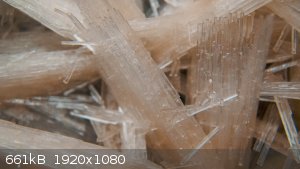 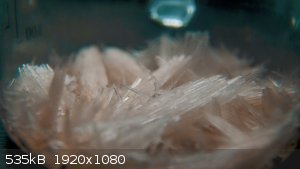 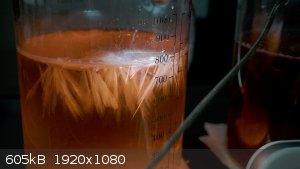 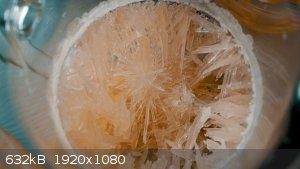 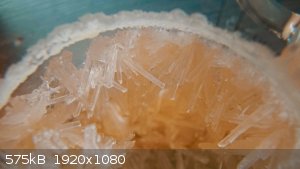 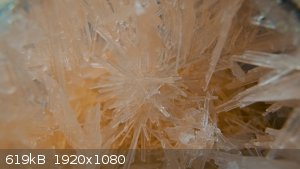 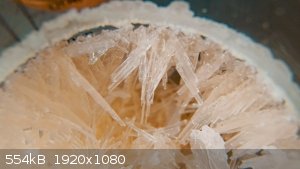
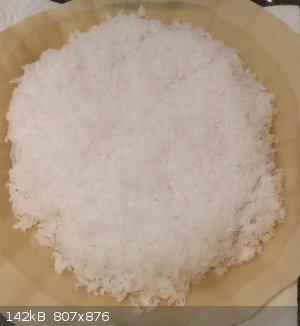
|
|
|
Fyndium
International Hazard
    
Posts: 1192
Registered: 12-7-2020
Location: Not in USA
Member Is Offline
|
|
For the record: activated carbon makes it pure white. The colorant has no effect to anything whatsoever. Better procedure allowed for extraction of
1100g of KNO3 from 2500g of starting material.
A question regarding of precipitating purer nitrate out of ammonium: could potassium chloride be used to precipitate KNO3 out directly? KNO3 has sol
of 133/L and ACl 300/L at 0C, so there should be reasonable play to secure a pure dropping. KNO3 is trivial to recrystallize as it has so low
solubility per unit, while one could say that water is dissolved into AN, not the other way, so any attempt will result in a mush, keeping all the
impurities, unless their solubility is very low to begin with, allowing filtering when concentrated.
|
|
|
| Pages:
1
2 |